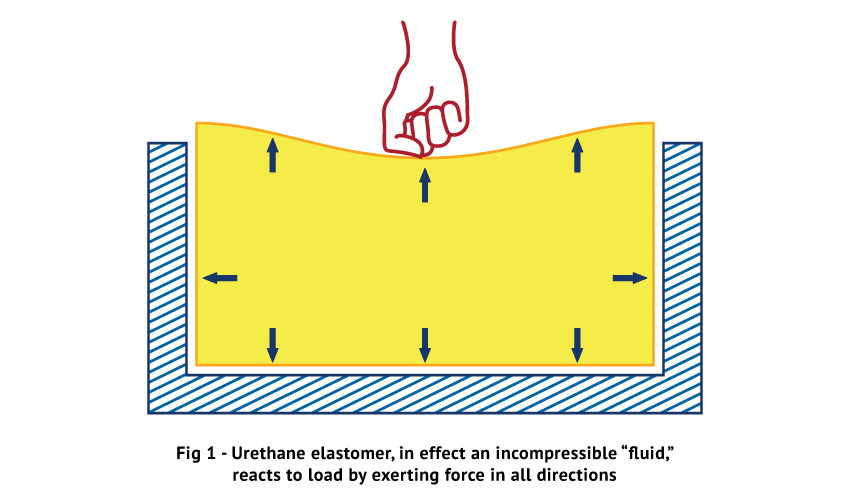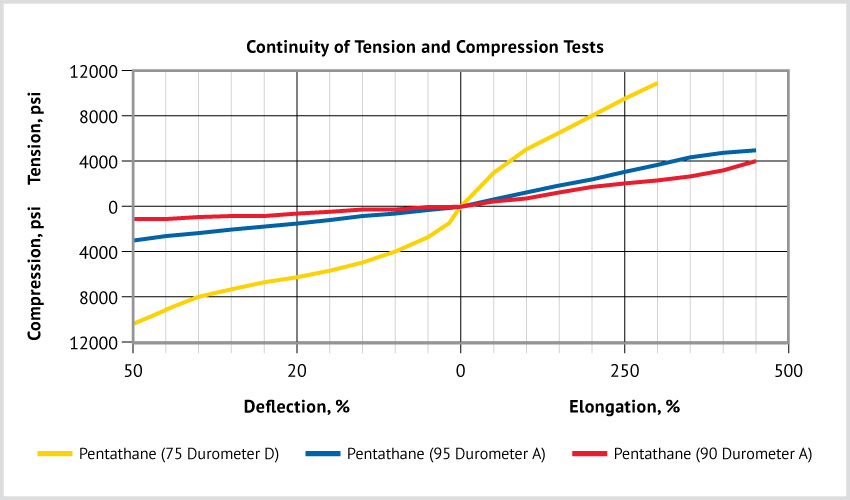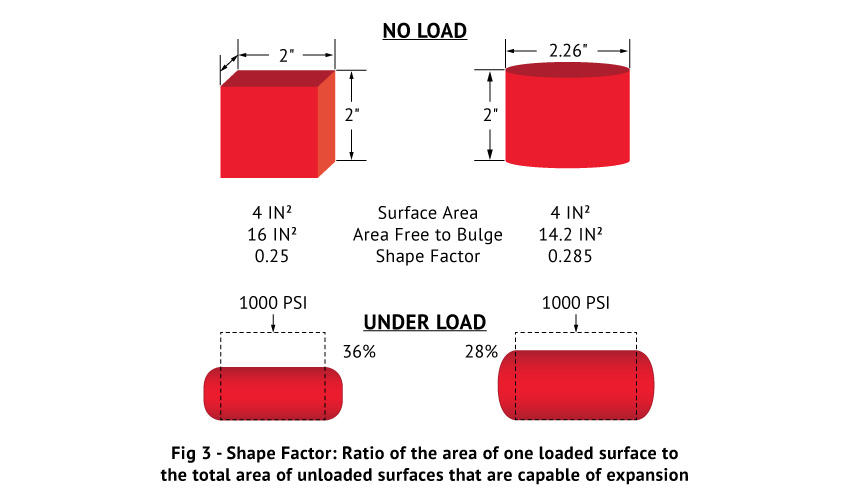When a load is applied to an elastomer, it “flows” in accordance with the force exerted on it, and also within the limits necessitated by either the mass of the material itself or by the dimensions of the elastomer’s container. In rubber technology, this occurrence is called compression. Although this term is correct in the framework of normal rubber usage, it may be misleading. It does not mean that, under pressure, the elastomer will undergo a change in volume. Rather, it means that the elastomer will deflect, or undergo a change in shape. This distinction is significant. An elastomer is an incompressible fluid, capable of altering its shape to the limit of its strength under load. When a load is placed upon it, the elastomer will react by tending to exert force uniformly in all directions. Even though the elastomer changes in shape under load, it is compelled by the characteristic of elasticity to resume its original shape once the load is removed.

Compression strains can be considered as extensions of tensile strains. But the compressive samples must be free to move. If rubber or urethane is bonded to a metal insert, or if they are tightly constrained in assembly, then movement is restricted, and the elastomer will be unable to readily change shape.
Compression curves are typically smooth and do not exhibit the “S” shape that is frequently observed in tensile tests. Compressive strain is limited to less than 100%, and thus the curve becomes asymptotic to the 100% line.
 While the ability to deform under compressive stress, and subsequently recover, is a characteristic property of elastomers, other factors ─ notably the shape of the part ─ affect the way an elastomer deforms during compression. To illustrate, consider two blocks cut from the same piece of rubber. One block is cylindrical with the proportions of an ice hockey puck; the other is a block of the same height and cross-sectional area, but rectangular in shape. If equal weights are placed on the blocks, thereby subjecting the blocks to the same compressive stress, the rectangular block will deflect more than the cylindrical block (Figure 3). Given that the blocks will not change in volume, compression instead yields a reduction in height, caused by the freedom of the blocks’ sides to bulge. The rectangular block deflects more than the cylindrical block because its sides provide a greater area that is able to expand.
While the ability to deform under compressive stress, and subsequently recover, is a characteristic property of elastomers, other factors ─ notably the shape of the part ─ affect the way an elastomer deforms during compression. To illustrate, consider two blocks cut from the same piece of rubber. One block is cylindrical with the proportions of an ice hockey puck; the other is a block of the same height and cross-sectional area, but rectangular in shape. If equal weights are placed on the blocks, thereby subjecting the blocks to the same compressive stress, the rectangular block will deflect more than the cylindrical block (Figure 3). Given that the blocks will not change in volume, compression instead yields a reduction in height, caused by the freedom of the blocks’ sides to bulge. The rectangular block deflects more than the cylindrical block because its sides provide a greater area that is able to expand.

The designer of elastomeric parts allows for this behavior in considering a concept called shape factor. Shape factor explains the role of shape in determining the behavior of a part with parallel load faces, when under compressive force.
This idea is very useful for the design engineer. If an elastomeric part does not deflect enough to perform as needed, the designer can reduce the part’s shape factor by increasing the thickness of the pad; that is, enlarging the area free to expand under load. Alternatively, if the pad deflects too much, the designer can reduce the area available to spread out under load. If changes in shape cannot be made, the designer may increase or decrease the hardness of the elastomer in order to adjust the part’s deflection under compressive forces.
Access more articles in our Rubber Knowledge Center and our Urethane Knowledge Center.



